

SPE 592c edTPA LP template Winter 2020 (1) 3 to 5 Consecutive Lesson Plan Brainstorm 2021 (1) Instructional Strategies List July 2015. 03 06 Instructional Strategies that Support Differentiation. Learner action verbs. Blooms poster WR. Word Art. IEP Process Flowchart. IEP Putting it into Perspective Revised. SMART Goals 1. Week 10 Overview. Categories of Disability under IDEA. LDCA Chart. Websites for ILTS Testing System LBS 1 155 and Special Education General Curriculum Test 163.
A Look at Assessment. A Look at Instruction. A Look at Social Emotional Behavioral. A Look at Collaboration. Spoken Language Disorders: Signs and Symptoms. Signs and symptoms of spoken language disorders (SLD) vary across individuals, depending on the language domain(s) affected, severity and level of disruption to communication, age of the individual, and stage of linguistic development.
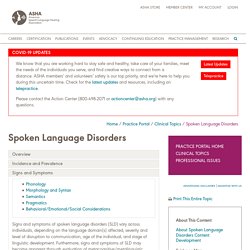
Furthermore, signs and symptoms of SLD may become apparent through evaluation of metacognitive/metalinguistic ability; when later-developing language domains, such as reading and writing (i.e., literacy), are developing; when children encounter the unique disciplinary language associated with certain academic subjects (e.g., humanities classes vs. science classes); or through observation of emotional/behavioral difficulty. Websites of Interest — Oregon Response to Instruction & Intervention. Neurodiversity The Future of Special Education. 7 Ways of Embracing Mistakes in the Classroom for Inspired Learning. Making mistakes used to be a bad thing.
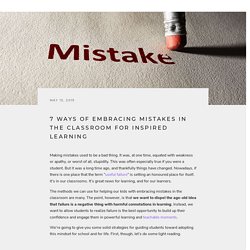
It was, at one time, equated with weakness or apathy, or worst of all, stupidity. This was often especially true if you were a student. But it was a long time ago, and thankfully things have changed. Nowadays, if there is one place that the term “useful failure” is setting an honoured place for itself, it’s in our classrooms. It’s great news for learning, and for our learners. The methods we can use for helping our kids with embracing mistakes in the classroom are many. We’re going to give you some solid strategies for guiding students toward adopting this mindset for school and for life. The Power of Failure Perhaps one of the most compelling articles written on the subject of encouraging mistakes in the classroom was written in 2015 by Helen Snodgrass. “When students first walked into my classroom this fall, many of them immediately noticed a large quote on the wall above the whiteboard:‘In this class, failure is not an option.
Why did we fail? How to Fix 5 Common Formative Assessment Problems Teachers Have. Assessment has its challenges to be sure, and formative assessment problems are a fact of life and learning.
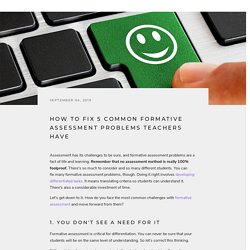
Remember that no assessment method is really 100% foolproof. There's so much to consider and so many different students. You can fix many formative assessment problems, though. Doing it right involves developing differentiated tasks. Giving Student Feedback: 7 Best Practices for Success. Part of being an educator is having the skills to make hard concepts easier to understand, and the ability to make any student feel accomplished no matter how much they're struggling.

It's all part of giving student feedback. Proper feedback should enable and inspire. It should make someone feel good about where they are, and get them excited about where they can go. These strategies for helping you with giving student feedback could be things that you already practice with your students. If so, then they're merely listed here as refreshers and possibly new takes on old ideas. Assessment. Objectives and Goals of a Lesson Plan.
Objectives, also known as goals, are the first step in writing a strong lesson plan.
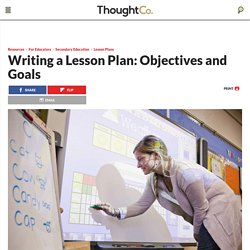
This article includes descriptions of the objectives of lesson plans, how to write them, examples, and tips. Goal-Writing Tips Whenever possible, write clearly-defined and specific objectives (goals) that are easy to measure. That way, at the conclusion of your lesson, it will be relatively easy to determine if you met or missed your objectives, and by how much. Objective In the objectives section of your lesson plan, write precise and delineated goals for what you want your students to be able to accomplish after the lesson is completed. What to Ask Yourself In order to define your lesson's objectives, consider asking yourself the following questions: What will students accomplish during this lesson?
Additionally, you will want to make sure that the lesson's objectives align with district and state educational standards for your grade level. Examples. Home. SPE 572 LP template .docx. IEP Process Flow. IEP Process Flowchart. IEP Putting it into Perspective Revised 3. Iep instructions. ISBE nc proc sfgrds 34 57j. IEP form. SMART Goals .pdf. Understanding, Developing, and Writing Effective IEPs. Wrightslaw Special Education Law and Advocacy. Blooms Taxonomy Handout. Using Webb’s Depth of Knowledge to Increase Rigor. Calculating Cognitive Depth For classroom teachers, the more important question is one of practice: How do we create rich environments where all students learn at a high level?
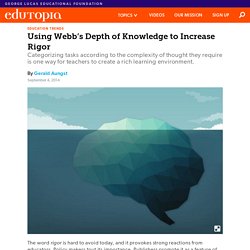
One useful tool, Norman Webb’s Depth of Knowledge Levels, can help teachers meet that challenge. Depth of Knowledge (DoK) categorizes tasks according to the complexity of thinking required to successfully complete them. Level 1. Recall and Reproduction: Tasks at this level require recall of facts or rote application of simple procedures. Level 2. Level 3. Level 4. Recently, educators have begun applying Webb’s DoK to help them design better instruction. Blooms Taxonomy.
BzcFVCvCUAEVk3d.jpg large. Revised Blooms Taxonomy Action Verbs. M1 Slide 19 DOK Wheel Slide.